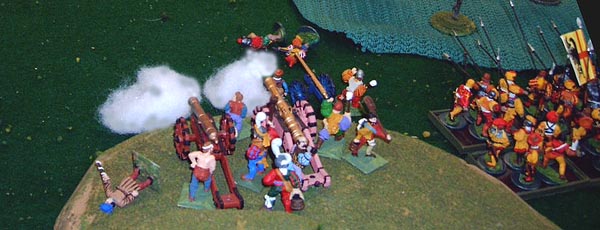
Photo by John Murdaugh
Our 25mm Rennaissance Game
The battle for Vermicelli/Pignoli
Using our Pikes and Gendarmes rules derived from the old Brom Standard rules - as are so many of our rules sets
Played at Hobbytown in North Jackson, December 4, 2004

Photo by John Murdaugh
The Imperialist Defenders of the "Bald Hill" hard at work, serving their guns. Note the Landsknect pikemen to the right, in support. They had their pikes bloodied before this battle was over.
In the late 1400s and early 1500s, the French Kings tried to conquer Italy. The Holy Roman Emperor and the King of Spain (often the same man) fought to prevent this. The flower of the young men of France and many, many hired mercenary soldiers perished in the attempt. France was never able to maintain the temporary conquests that they made, from time to time, in Italy .
This game represents a smaller action in those Italian Wars. The Game-master was Jay Stribling, who designed a simple but balanced scenario, so that he could fight in the game. Then with great care, he chose the loosing side. Equipped with the finest cavalry in Europe, the Gens d'armmes of France, he let himself be defeated by inferior numbers of heavy cavalry and swarms of varlets on horseback with firearms. This is not the way to fight! Sobbing into his beer, Jay wrote this battle report.
This game was played with exactly the same forces as our previous three Renaissance games. Both sides set the terrain up (a few hills and woods) by mutual agreement. There was a town on each side (Vermicell for the French, Pignoli for the Imperialists) along with two small groups of wagons/supplies. Therefore, each army had three points to defend and three to attack. Randomly, each of the objectives was worth one, two or three victory points. Also each side would received one victory point for each enemy unit destroyed, driven from the feild, reduced to "spent" status, or in rout at the time that play ceased.
John Murdaugh, Sean Pitts, and Mark Gilbert were the imperialists. The French, and their mercenary Swiss pikemen were gamed by Jim Pitts, Phil Young, and Jay Stribling.
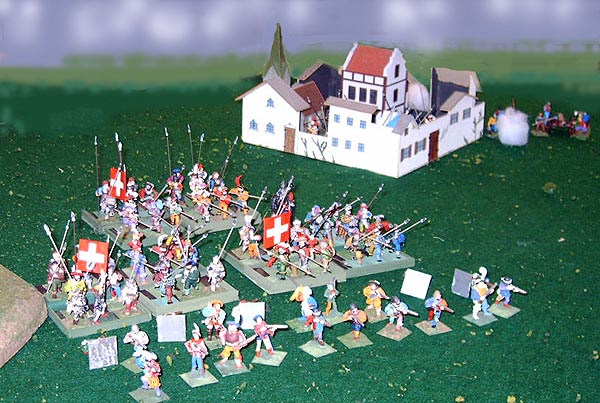
Photo by John Murdaugh
The assault force of the Swiss, under General Pitts, headed across from the French-held town of Vermacelli, headed north towards the "bald hill" and the Imperialist's town of Pignoli.
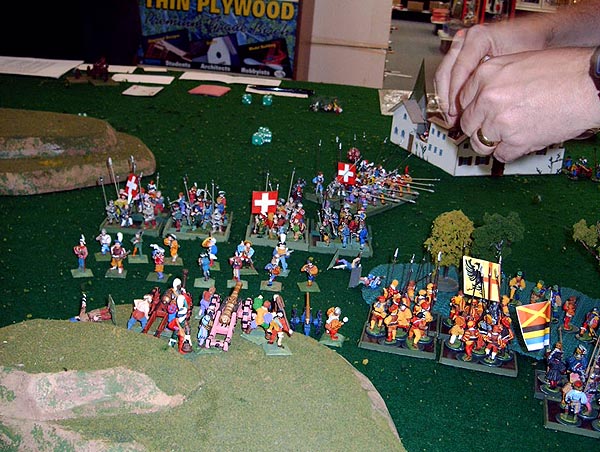
Photo by John Murdaugh
A view from the top of 'Bald hill' which formed the strongpoint of defense on the Imperialist right flank. You can see Imperialist heavy guns on the hill, and two units of Landskneckt pikemen to the right. Three units of Swiss pikes (red flags with white crosses) are out in front, headed for the hill, screened by a unit of French arquebusiers.

Photo by John Murdaugh
Two of the pike units are closing upon the hill, being fired upon by the great guns, and some imperialist arquebusiers at the bottom of the photo.
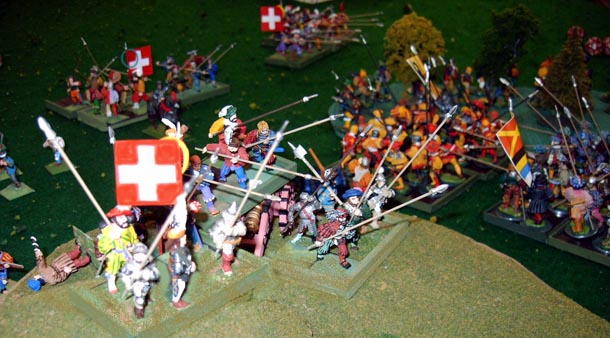
Photo by John Murdaugh
The Swiss have taken the hill but this unit has taken 6 casualties out of twnety men. The yellow ring on the flagstaff indicates that this Swiss pike unit has 4 morale points - an elite unit indeed.
In our games, units dice to see what their initial morale is, when they first take a casualty. A morale rating of 1 point (red ring) indicates the poorest morale state. Two points (Green or white ring) is better, while a three point rating (blue ring) is above average. Four points (Gold ring) is the best allowable.
Since six points are needed to pass any morale test, and the test is taken by adding the score of a D6 to the morale state of the unit, you can see that only a die roll of '1' on a D6 can cause a gold-ringed unit to fail. Conversely, only a die result of '5' or '6' on a D6 will allow a red-ringed unit to pass.
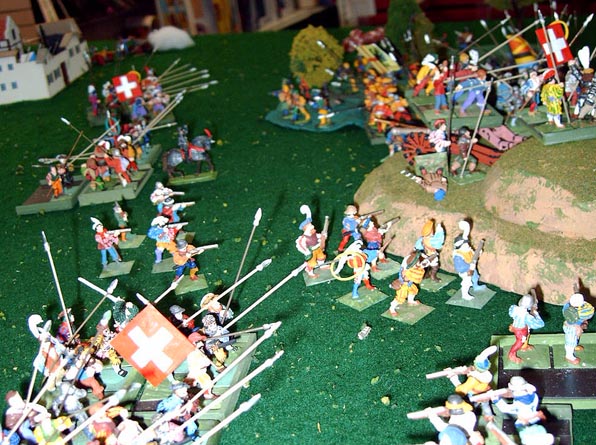
Photo by John Murdaugh
The struggle for the hill seen from a bit farther away. A supporting Swiss pike unit in the middle distance has fallen back (officer in grey steel armor in front attempting to rally it) while in the forground, Landsknect arquebusiers pour fire into another Swiss unit.
If there can be any theme to all of these games in this series, it has been that firepower has proven decisive over shock action.

Photo by John Murdaugh
The French and Swiss players seem to be reacting in shock to some development on the field. Actually this is probably the Major morale break of the Swiss/French forces that removed all their routed units from the battlefield and routed all "red-ringed" units (that had only a one morale point rating). As the BORG might say of the remainder of the game: "resistance is futile".
All of our Renaissance figures are on single-figure steel bases. We mount these on magnetized stands which hold three mounted figures or five foot figures. Originally we used The Sword and the Pike rules which were more of a skirmish set and the figures were individually based for that.
From time to time, we have thought of remounting the figures on multiple-man bases, but as soon as we do that, we might need individual mounted figures again!
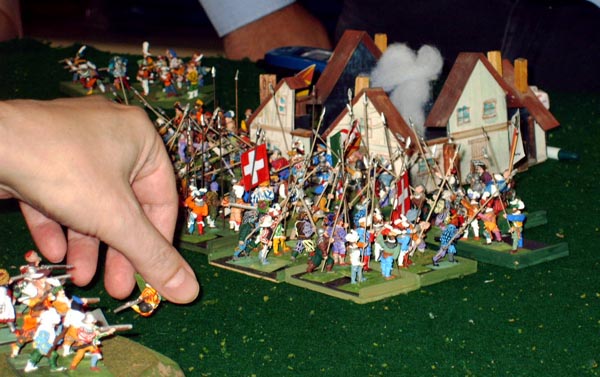
Photo by John Murdaugh
This is why we play these games, the color, the excitement! Phil Young's hand is visible adjusting his troops at the Swiss' pikemen's high water mark. They got right up to Pignoli, but were driven back by John Murdaugh's Landsknect pikemen and perforated by the shot from his Landsknect arquebusiers. They fell back, and John held the town.
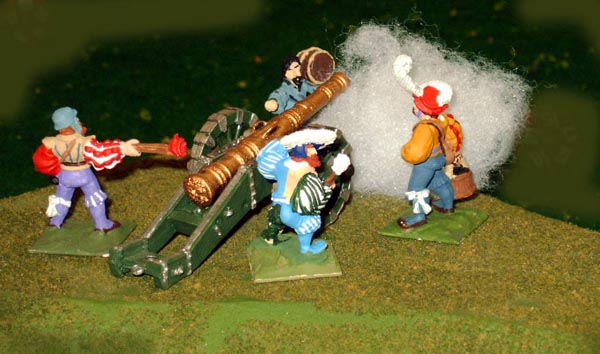
Photo by John Murdaugh
The heavy gun on the French players right hand side of the field (the east side) bangs away. This caliber of guns we allow to fire every other turn, and they may not move once they begin to fire. This gun was firing at long range and it's main effect was to knock over a few Landsknect pikemen. On one turn it stopped a cavalry charge against Stribling's light guns by enfilade fire, removing the entire front rank, but mainly our heavy guns' effect was attritional.
The Imperialist heavy guns were shooting at very short range, as the Swiss move upon them and units supported by them. Several were run over by the Swiss pikes, the gunners making thier escape as the Swiss came upon them. They were in the thick of the action, and added more to their side's performance than did the French guns.
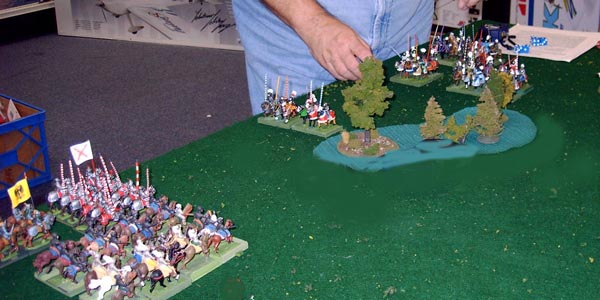
Photo by John Murdaugh
This is during the set-up on the eastern flank of the battlefield. Mark Gilbert's forces are nearest to the camera, on the left of the image. He had three "reiter" units of German pistol-armed cavalry, plus one unit of heavily armored Gens d'Arme cavalry - the ultimate successors of the Medieval Knights.
Jay Stribling, placing units, on right, had three units of Gens d'Armes, and was indifferantly supported by two light cannons and one heavy gun. When he realized that he had to advance through a defile, sweep superior numbers of lighter cavalry out of the way, many of which had superior mobility and could evade him...he had a bad feeling about the day's work ahead of him. His forbodings came true. He lost his a*s - err, lost his command.
Victory Points were awarded for:
Each town occupied, or wagon train held: The listed amount of points on the slip of paper randomly placed under the town, or supply train. Each item was worth 3, 2, or 1 point.
Each enemy unit driven from the field or in spent/routed at games' end: 1 ponit.
The Imperialists had 14 points at games end, and the Swiss/French had 7 points.
The Forces Involved for each side:
|
The French/Swiss forces: Three units (12 figures each) of Gendarme Heavy Cavalry
|
|
The Imperialist forces: One unit (12 figures) of Gendarme Heavy Cavalry
|
Who were the victors in this game?
The Imperialists won the game, overwhelmingly. The Imperialists had 14 points at games end, and the Swiss/French had 7 points. Not a good day for the French and Swiss and not a good series. Out of five games (we played the first game twice) the French and Swiss alliance won ONE game. No wonder they lost Italy!
Go to the first battle in this series of 4 games.
Go to the second battle in this series of 4 games.
Go to the third battle in this series of 4 games.
Go to the rules Pikes and Gendarmes that we used in this game.
Return to the Master list of Photos and Games
Return to the Jackson Gamers' Medieval and Renaissance Page
Return to the Jackson Gamers' homepage
Angelfire - Free Home Pages
Free Web Building Help
Angelfire HTML Library
htmlGEAR - free polls, guestbooks, and more!
Thank you for visiting The Jackson Gamers' pages at Angelfire. Please come back and visit again!